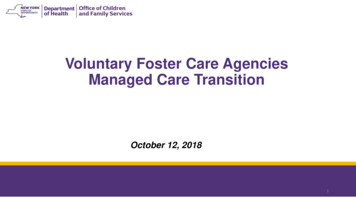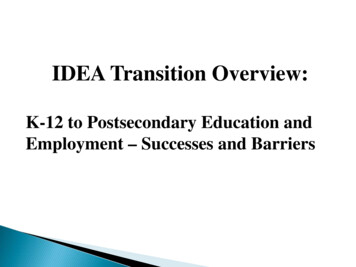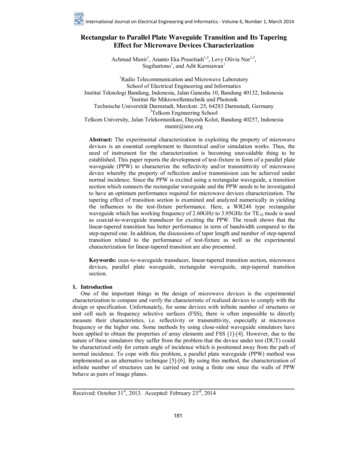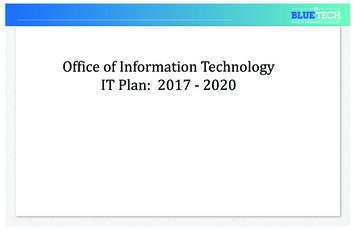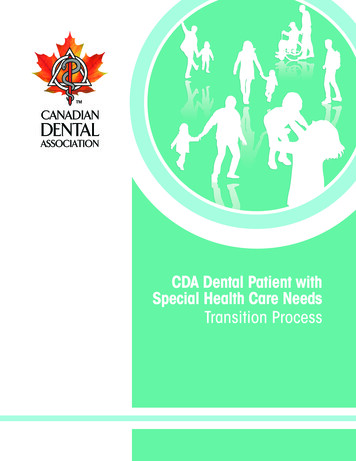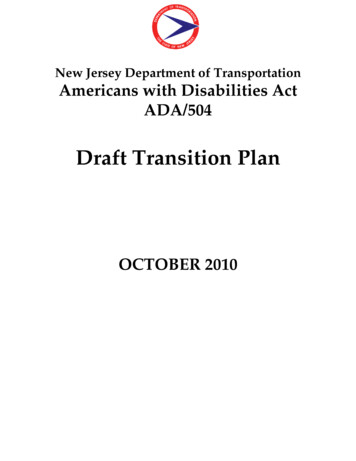
Transcription
New Jersey Department of TransportationAmericans with Disabilities ActADA/504Draft Transition PlanOCTOBER 2010
New Jersey Department of TransportationAmericans with Disabilities ActADA/504Draft Transition PlanOctober 2010
New Jersey Department of TransportationAmericans with Disabilities ActADA/504Draft Transition PlanOCTOBER 2010
New Jersey Department of Transportation Draft ADA/504 Transition PlanTable of Contents1.0Introduction . 1-11.1 Framework for ADA Compliance . 1-21.1.1 Fulfilling Administrative Requirements of Program . 1-31.1.2 Conducting a Self-Assessment . 1-41.1.3 Developing an Implementation Plan . 1-61.1.4 Monitoring Progress . 1-62.0Draft Transition Plan . 2-12.12.2Required Plan Elements . 2-1Projects Covered by ADA and Section 504 . 2-12.32.4Relationship to the Transportation Planning Process . 2-2Review Process . 2-22.4.1 Internal Review. 2-32.4.2 External Review . 2-32.53.0Future Plan Updates . 2-3NJDOT Progress to Date . 3-13.1 Administrative Requirements of ADA. 3-13.1.1 Designation of ADA Coordinator . 3-13.1.2 Notice of ADA Requirements . 3-23.23.1.3 Establishment of Grievance Procedure . 3-33.1.4 Sub-Recipient Assurances to FHWA . 3-5Interdepartmental Coordination. 3-53.2.1 Establishment of ADA Work Group . 3-53.2.2 Training, Awareness, and Information Dissemination . 3-63.2.3 NJDOT Web Accessibility . 3-93.2.3 Other Accomplishments . 3-93.3Activities to Support Draft Transition Plan Development . 3-103.3.1 Self-Evaluation . 3-103.3.2 Assessment of Best Practices. 3-123.3.3 Review of Documents for ADA Compliance . 3-133.3.4 Gap Analysis of Existing Information, Policies, andPractices . 3-133.3.5 NJDOT Policies and Procedures. 3-13
Table of Contents, continued4.05.06.07.0Draft Transition Plan . 5-194.1Facilities Site Inspections . 5-194.2Curb Ramps . 5-19Next Steps . 5-195.1Immediate Activities (Current Year) . 5-195.2Short-Term Activities (1 to 2 years) . 5-1915.35.4Intermediate-Term Activities (3 to 5 Years) . 5-202Long-Term Activities (6 to 10 years) . 5-202Monitoring and Evaluation . 6-2216.1Criteria for Evaluation . 6-226.2Process for Monitoring and Evaluation. 6-22Appendices . 7-17.1 Appendix A . 7-17.27.3Appendix B. 7-1Appendix C . 7-17.47.57.6Appendix D . 7-1Appendix E. 7-1Appendix F . 7-17.77.8Appendix G . 7-1Appendix H . 7-17.9 Appendix I . 7-17.10 Appendix J . 7-17.11 Appendix K . 7-27.12 Appendix L. 7-27.13 Appendix M . 7-227.14 Appendix N . 7-27.15 Appendix O . 7-22ii
New Jersey Department of Transportation Draft ADA/504 Transition PlanList of TablesTable 1.1 Accessibility Barriers Checklist. 1-5iii
New Jersey Department of Transportation Draft ADA/504 Transition PlanList of FiguresFigure 6.1 Federal Funding Opportunities for Pedestrian Projects andPrograms . 7-1v
New Jersey Department of Transportation Draft ADA/504 Transition Plan1.0 IntroductionThe Americans with Disabilities Act (ADA) of 1990 – also referred to as the “Act”or “ADA” – prohibits discrimination against persons with disabilities throughfive separate Titles, each of which targets a different aspect of potentialdiscrimination. Title II specifically addresses accessibility to public services andpublic transportation by persons with disabilities. The Act applies to facilitiesbuilt before and after 1990, and requires State and local governments and publicentities/agencies to perform Self-Evaluations of their current facilities relative tothe accessibility requirements of the ADA. Agencies are then required todevelop a program access plan – otherwise referred to as a Transition Plan – toaddress deficiencies identified in their Self-Evaluations.The New Jersey Department of Transportation (NJDOT) was recently tasked bythe Federal Highway Administration (FHWA) to provide a substantive update toits 1993 Transition Plan. In its approach to meet this directive, NJDOT contractedwith Cambridge Systematics, Inc. to assist in drafting a current Transition Plan.This Draft Transition Plan demonstrates NJDOT’s initial progress and necessaryfuture steps to satisfy FHWA by complying with Section 504 of the RehabilitationAct of 1973 (Section 504) (29 U.S.C. §794) and Title II of ADA (42 U.S.C. §§1213112164).1 These two laws work together to achieve the goal of making publicrights-of-way and facilities accessible to persons with disabilities.2 This DraftTransition Plan is essentially a compilation of Cambridge Systematics’ fivemonths of in depth discussions and interviews with key NJDOT ADAstakeholders along with ADA national best practices.1Department of Justice (DOJ) ADA regulations govern accessibility requirements anddesignate the Department of Transportation (DOT) as the responsible agency foroverseeing public agencies’ compliance with the ADA (per 28 CFR Section 35.190(b)(8).The DOT, in turn, has delegated to the Federal Highway Administration (FHWA) theresponsibility to ensure ADA compliance in the public right-of-way and on projectsusing surface transportation funds.The FHWA ensures compliance through several means, including: a) program oversightover all Federal, State, and local government agencies that build and maintainhighways and roadways, b) project oversight over Federal-aid highway constructionactivities (including project planning, design and construction programs); andc) investigation of Title II ADA/ Section 504 formal complaints and its own knowledge ofspecific problems.2The public right-of-way consists of everything between right-of-way limits, includingtravel lanes, medians, planting strips, sidewalks, and other facilities.1-1
New Jersey Department of Transportation Draft ADA/504 Transition PlanThe NJDOT Division of Civil Rights over the past two years has undertakenadditional responsibilities related to Title II and Section 504, in concert with itsongoing duties related to Title VI, which prohibits discrimination on the basis ofrace, color, and national origin in programs and activities receiving Federalfinancial assistance. Therefore, the ADA Program at NJDOT with respect to TitleII and Section 504 is in a very early stage of development regarding its roles,functions, and activities.Its accomplishments are reported in this DraftTransition Plan in terms of an evolving program that will— over time andthrough progressive incremental improvements—develop the required elementsthat are more in line with best practice approaches seen in more matureprograms.The limitations of this Draft Transition Plan include gaps in information andaggregate data from which a baseline inventory can be established, as called forin the Self-Evaluation process. This baseline information is needed to measureincremental improvements to accessibility over time through an annual curbramp installation schedule, as intended by the spirit of the Transition Plan. Inspite of this gap, this Draft Plan identifies a series of steps that can be undertakenin the near, medium, and long-term to advance the ADA program incrementallyto meet this stretch goal of developing a curb ramp schedule over time, withinthe staff, time, and budget constraints of the current program. An integral partof achieving steady progress toward this goal requires the securing of funding tocollect and maintain additional data that can be used to quantify the current anddesired state of the program.1.1FRAMEWORK FOR ADA COMPLIANCERelative to all public agencies that fall under Title II and Section 504requirements, State Departments of Transportation (DOTs) face uniquechallenges in meeting ADA accessibility of the facilities they own or manage.The sheer size and geographic extent of State DOT facilities can easily spanthousands of miles of public rights-of-way, magnifying the complexity and costof efforts to achieve, maintain, and track compliance over time. A recent guidetitled “ADA Transition Plans: A Guide to Best Management Practices” (hereafterreferred to as the Guide) recognizes these challenges, while laying out a solidgroundwork for achieving compliance through a phased, step-like approach ofdemonstrated activities and accomplishments over time.3Due in part to the management complexity that State DOTs face, having aframework in place that articulates a series of successive, positive steps towardcompliance – and then using a best practices or “ideal” approach to ADA31-2NCHRP Report 20-7 (232), ADA Transition Plans: A Guide to Best Management Practices,National Academy of Sciences, National Cooperative Highway Research Program, May2009.
New Jersey Department of Transportation Draft ADA/504 Transition Plancompliance as a yardstick to gauge the magnitude of its own efforts – may be auseful tool for NJDOT as it strives toward more concrete and substantiveachievements over time and within its existing budget constraints.In summary, the Guide outlines seven specific steps for achieving an “idealscenario” for meeting ADA requirements with respect to the accessibility offacilities in the public right-of-way. These steps have been reorganized into thefollowing functional areas: Step 1 – Fulfilling the administrative requirements of the ADA programthrough the designation of a dedicated staff person, provision of ADA notice,and adoption of procedures for resolving complaints in a timely and effectivefashion. Step 2 – The second step involves the performance of a self-assessment (or“Self-Evaluation”) of areas of compliance in which the agency falls short,including its internal and external ADA processes and the condition of itsmanaged facilities. Step 3 – As a follow-up to the self-assessment (or “Self-Evaluation”), Step 3 isthe development of a implementation plan (or “Transition Plan”) to improveADA accessibility and compliance with Title II and Section 504 throughseveral required elements, including the development of a curb rampinstallation schedule. Step 4 – The last step involves monitoring the progress of the implementationplan, conducting regular updates to ensure the plan and its priorities arevalid and that compliance efforts are effective and properly directed.1.1.1 Fulfilling Administrative Requirements of ProgramEach State DOT has a responsibility to establish a basic program that meets theadministrative requirements of the ADA. The basic elements of an ADAprogram include:Designation of an ADA CoordinatorAs a first step, each DOT must designate one responsible staff to coordinate ADAcompliance with Title II across the Department, to investigate complaints relatedto Title II, and to serve as a single source for ADA information inside and outsidethe Department. This person would likely interface with local governments,advocacy groups, and the public, and be dedicated full-time to advancingcompliance plans within the Department.Provision of Notice Regarding ADA RequirementsADA’s assurance of program accessibility dictates that services and programsoffered by public entities— including DOTs—should be accessible to individualswith disabilities and ensure that they are not excluded because of limitations onaccess. Various methods of ensuring program accessibility include redesign,1-3
New Jersey Department of Transportation Draft ADA/504 Transition Planalteration of facilities, relocation of services or programs to an accessible locationin a facility or to an accessible facility altogether. An important and relatedcomponent of accessibility is the provision of information to the public aboutADA. The provision of notice about the rights of the public under the ADA is acontinuing responsibility of DOTs, which must determine the most effective wayto accomplish this goal.The target audience for public notice is expansive and encompasses anyone whoalready interacts, or could potentially interact, with the DOT – includingapplicants, beneficiaries, and other people interested in the DOT’s programs,activities, or services. The notice should include information about Title II of theADA and how it applies to the programs, services, and activities of the DOT.The presented information must be accessible to all, and therefore be provided inalternative formats including: audio tape, large print notice, Braille notice,HTML format in website content, provision of translators, and advertisements inpublications with large print versions, etc.Adoption and Publishing of Grievance ProceduresDOTs are required to adopt and publish procedures for resolving grievancesarising under Title II of the ADA so that complaints of disability discriminationare resolved in a prompt and fair manner. Once developed, the grievanceprocedure should be distributed to all agency heads. Copies should be posted inpublic spaces of the building and on the DOT’s website. The procedure must beavailable in alternative formats so that it is accessible to all people withdisabilities.While Title II and its implementing regulations do not specify what ADAgrievance procedures must include, the Department of Justice (DOJ) hasdeveloped a model procedure that includes the following elements: A description of how and where a complaint under Title II may be filedwith the government entity; If a written complaint is required, a statement notifying potentialcomplainants that alternative means of filing will be available for peoplewith disabilities who require such an alternative; A description of the timeframes and processes to be followed by thecomplainant and the government entity; Information on how to appeal an adverse decision; and A statement of how long complainant files will be retained.1.1.2 Conducting a Self-AssessmentThe development of a Transition Plan first begins with a Self-Evaluation, orinventory, of existing physical barriers in the 750 facilities managed by NJDOT,and a listing of all barriers that limit accessibility. Potential approaches for1-4
New Jersey Department of Transportation Draft ADA/504 Transition Planconducting this inventory include on-ground surveys, windshield surveys, aerialphoto studies, and drawing reviews.An Accessibility Barriers Checklist provided in the Guide highlights severalareas where deficiencies are likely to be found, as shown in Table 1.1 below:Table 1.1Accessibility Barriers ChecklistISSUEPOSSIBLE BARRIERSSidewalk and Pathway Clear WidthNarrow, Below GuidelinesSidewalk and Pathway Cross SlopeSteepness, Irregularity, Variability, WarpingLandings Along Sidewalks and Pathways Less Than 4 feet by 4 feetSidewalk and Pathway GradeSteepness, Angle PointsMaterials and FinishesDeterioration of Surfaces, Deterioration of Markings,Appropriateness of material (ex. Cobblestones)GratingsGrating Type, Grate Opening OrientationDiscontinuitiesMissing Sections, Gaps, Drops, StepsDetectable Warning SystemMissing, Inappropriate Materials, Inadequate Size, WrongLocationObstructionsSigns, Mail Boxes, Fire Hydrants, Benches, Telephones, TrafficSignal Poles, Traffic Signal Controller Boxes, Newspaper Boxes,Drainage Structures, Tree Grates, Pole Mounted Objects,Standing Water, Snow or IceTraffic Signal SystemsLack of Provision for the Visually Impaired such as APS,Inadequate Time Allowed, Inoperable Buttons, InaccessibleButtonsCurb RampMissing, Does not Fall within Marked Crosswalk, Doesn’tConform to GuidelinesCurb Ramp FlaresMissing Where Required, Too SteepSource: NCHRP Report 20-7 (232), ADA Transition Plans: A Guide to Best Management Practices, National Academy ofSciences, National Cooperative Highway Research Program, May 2009.The development of such an inventory has been reported as the most challengingpart of the Transition Plan process by several State DOTs, which often lack thebudgetary and staff resources to undertake and complete this time-consumingand complicated task. Many states have reported being unable to progress pastthis inventory stage in order to move forward and use the collected data todevelop priorities for future upgrades.As a result, the Best Practices Guide recommends some potential approaches forthe DOTs to move forward:1-5
New Jersey Department of Transportation Draft ADA/504 Transition Plan Identifying dedicated funding and staffing prior to undertaking SelfEvaluation activities; Dividing the entire effort into two separate inventories— one solely forbuildings and the other one for the right-of-way—so that a portion of thecompliance effort can occur on a more accelerated schedule; Using phasing and prioritization to focus the initial stages of the inventoryeffort on the areas identified as most important based on criteria such as highpedestrian traffic areas or areas more commonly used by pedestrians withdisabilities; and Dividing the inventorying tasks across regions or districts, with eachregion/district responsible for Self-Evaluation and development of anindividual Transition Plan specific to its own geographic area.1.1.3 Developing an Implementation PlanOnce the Self-Evaluation is completed and the DOT has an inventory of requiredstructural modifications to achieve accessibility, the DOT must develop a planfor removing the identified barriers where they exist. While there is considerablevariation between existing Transition Plans across State DOTs, each plan mustcover at least four required elements, in addition to the involvement of the publicand availability of the plan for public review. These elements include a) theinventory from the Self-Evaluation, b) discussion of methods to remove barriersand improve accessibility, c) a schedule for taking steps to achieve compliance,and d) an identified individual responsible for the plan’s implementation.Curb ramps receive special consideration in the Transition Plan because they area vital to making sidewalks, street crossings, and other pedestrian routes thatmake the public right-of-way accessible to people with disabilities. Specifically,the Transition Plan requires a separate schedule dealing with remediation ofcurb ramp issues. The use of a ranking system based on several variables—toinclude location, degree of use, and degree of non-compliance—is viewed by theBest Practices Guide as a sound strategy to deal with this long-term issue.1.1.4 Monitoring ProgressThe final key step in achieving improvements in ADA compliance is continuousattention to incremental improvements and whether these are meeting the goalsand targets set out in the Transition Plan schedule. As an example, progress canbe monitored by ensuring that “x” percent of access ramps are installed every“y” years with the goal of “z” percent completion in a specified number of years.The key for effective monitoring relies on the setting of goals and targets bywhich to measure progress on an annual basis.1-6
New Jersey Department of Transportation Draft ADA/504 Transition Plan2.0 Draft Transition PlanAs a key component of ADA compliance, the Transition Plan and its requiredand related elements – including its context within the transportation planningprocess and relevant projects covered by Title II/ Section 504, plan stakeholders,the review process, and future updates — are discussed in this section.2.1REQUIRED PLAN ELEMENTSPer 28 CFR §35.150(d)(3)(9-12-06), Title II requires the Transition Plan toaccomplish the following tasks, at a minimum:2.2 Identify physical obstacles in a public agency’s facilities that limit theaccessibility of its programs or activities to individuals with disabilities; Describe in detail the methods that will be used to make the facilitiesaccessible; Specify the schedule for taking the steps necessary to upgrade pedestrianaccess to meet ADA and Section 504 requirements in each year followingthe Transition Plan; Include a schedule for providing curb ramps or other sloped areas wherepedestrian walks cross curbs, giving priority to walkways serving entitiescovered by Title II, including State and local government offices andfacilities, transportation, places of public accommodation, and employers,followed by walkways serving other areas; Indicate the official responsible for the implementation of the plan; and Provide opportunities to interested persons and groups to participate inthe development of the plan, including the Self-Evaluation leading to theplan.PROJECTS COVERED BY ADA AND SECTION 504Any project for construction or alteration of a facility that provides access topedestrians must be made accessible to persons with disabilities. Projects thatalter the use of the public right-of-way – by making any changes that affect orcould affect access, circulation, or use by affecting the structure, grade, or use ofthe roadway – must incorporate pedestrian access improvements within thescope of the project to meet the requirements of the ADA and Section 504.2-1
New Jersey Department of Transportation Draft ADA/504 Transition PlanAlterations include reconstruction, major rehabilitation, widening, resurfacing,signal installation and upgrades, and projects of similar scale and effect4.Maintenance activities and resurfacing beyond normal maintenance are notconsidered to be alterations, per the Department of Justice (DOJ). The FHWAconsiders the following to be maintenance activities: actions intended to preservethe system, forestall future deterioration, and maintain the functional conditionof the roadway without increasing the structural capacity such as nonstructuralthin surface treatments, joint repair, pavement patching, shoulder repair, signing,striping, minor signal upgrades, and repairs to drainage systems.2.3RELATIONSHIP TO THE TRANSPORTATIONPLANNING PROCESSThe Transition Plan is intended to identify system needs and integrate them withthe State’s planning process through the Statewide Transportation ImprovementProgram (STIP) and metropolitan Transportation Improvement Program (TIP)documents. In order to be effective, a Transition Plan needs to be used in theannual planning of projects and related funding decisions5.Agencies should incorporate accessibility improvements into the transportationprogram on an ongoing basis through the following means:2.4 Any programmed constructionrequirements when built;projectsmustmeetaccessibility Accessibility improvements identified in the Transition Plan that are notwithin the scope of an alteration project should be incorporated into theoverall transportation planning process, even as stand-alone projects; and During scheduling maintenance activities, agencies should identify ADAaccessibility needs and incorporate them into the overall transportationplanning process.REVIEW PROCESSTransition Plans should be reviewed by at least three main groups ofstakeholders: 2-2Internal stakeholders that include DOT staff and individuals responsible forthe development of the Plan within the agency;4Source: Federal Highway Administration Office of Civil Rights, “Questions andAnswers About ADA/Section 504” accessed at:http://www.fhwa.dot.gov/civilrights/ada qa.htm5Ibid
New Jersey Department of Transportation Draft ADA/504 Transition Plan External stakeholders that include the FHWA, as part of its program, project,and investigative oversight role of its Federal-aid sub-recipients; and External groups of interested individuals who represent the public-at-large orare assembled or identified by the DOT for providing input throughout theSelf-Evaluation and Transition Plan development process.2.4.1 Internal ReviewSection 504 requires FHWA to monitor compliance of Federal-aid recipients withrespect to their Self-Evaluation and Transition Plans. As defined in thestewardship plan, FHWA Division offices are tasked with reviewing pedestrianaccess compliance with the ADA and Section 504 as part of their routineoversight activities.A Transition Plan should be periodically reviewed by agency staff through aSelf-Evaluation process, which should take place both prior to and followingTransition Plan completion. These Self-Evaluation activities are intended togauge the level of existing compliance and determine the potential need foradditional areas of inclusion for accessibility improvements.Identifieddeficiencies should be catalogued and included in future Transition Planupdates.2.4.2 External ReviewIn addition to agency staff, the public-at-large is a key stakeholder in ADAcompliance and the agency’s efforts to make steady, incremental improvementsthrough the Self-Evaluation and Transition Plan processes. Opportunities forparticipation in the Self-Evaluations that lead to the development of a TransitionPlan should be actively advertised as part of a more formal public outreach effortto members of the disabled community, interested persons, and other publicstakeholders. A more comprehensive list of potential stakeholders for the reviewprocess include: activists, advocacy groups, general citizens, organizations thatsupport the rights of the disabled, elected officials, State-designated bodies orcommittees, or a State Ombudsman.Potential sources for disseminating information and making requests forcomments throughout the Self-Evaluation process include: awareness days,newsletters, and information on the DOT website. Comments can be gatheredthough various means, including meeting comment forms, meetingtranscriptions, a dedicated hotline, e-mail or written correspondence addressedto the agency. Completed Self-Evaluation and Transition Plan documents arerequired to be available for public inspection and review.2.5FUTURE PLAN UPDATESWhile there is no required timeline for making future updates to a TransitionPlan, agencies should engage in Self-Evaluation activities as necessary to ensure2-3
New Jersey Department of Transportation Draft ADA/504 Transition Planthat the Transition Plan document is current and meets the needs of disabledpersons. Since each plan is required to have an annual schedule that is ideallyaligned with annual funding allocations through transportation planning andprogramming mechanisms, annual milestones should be adjusted regularly toreflect any changes in real world conditions.2-4
New Jersey Department of Transportation Draft ADA/504 Transition Plan3.0 NJDOT Progre
its 1993 Transition Plan. In its approach to meet this directive, NJDOT contracted with Cambridge Systematics, Inc. to assist in drafting a current Transition Plan. This Draft Transition Plan demonstrates NJDOT's initial progress and necessary future steps to satisfy FHWA by complying with Section 504 of the Rehabilitation

